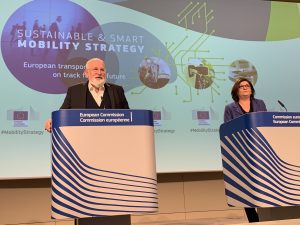 The European Commission has published the Sustainable and Smart Mobility Strategy which will transform the EU transport system and will support the achievement of the European Green Deal.
The European Commission has published the Sustainable and Smart Mobility Strategy which will transform the EU transport system and will support the achievement of the European Green Deal.
The strategy together with an Action Plan of 82 initiatives will guide the directions EC has to implement for a reduction of 90% in emissions by 2050, delivered by a smart, competitive, safe, accessible and affordable transport system. This strategy lays the foundation for how the EU transport system can achieve its green and digital transformation and become more resilient to future crises.
The “strategy will shift the way people and goods move across Europe and make it easy to combine different modes of transport in a single journey. We’ve set ambitious targets for the entire transport system to ensure a sustainable, smart, and resilient return from the COVID-19 crisis,” Frans Timmermans, the Executive Vice-President for the European Green Deal, said.
According to the EU Sustainable and Smart Mobility Strategy, all the transport modes need to become more sustainable, with green alternatives widely available and the right incentives put in place to drive the transition. Concrete milestones will keep the European transport system’s journey towards a smart and sustainable future on track.
“Through the implementation of this strategy, we will create an irreversible shift to zero-emission mobility while making our transport system more efficient and resilient,” Commissioner for Transport Adina Vălean said.
The strategy has three deadlines – 2030, 2035 and 2050 that will support the EU transition towards a sustainable transport system, based on the railway transport that has an important role to achieve the Green Deal goals. Thus, on the rail sector, by 2030, high-speed rail traffic will double across Europe and by 2050, it will triple, and over the next three decades, the rail freight transport will double.
These objectives will contribute to a decisive action to shift more activity towards sustainable transport notably increasing the number of passengers travelling by rail and commuting by public transport active modes, as well as shifting a substantial amount of freight into rail and inland waterways and short sea shipping.
According to the vision the European Year of Rail 2021 is “an excellent opportunity for the Member States, the EC and the rail sector to boost the cross-European connections”.
In 2021, The Commission will propose an action plan to boost long-distance and cross-border rail passenger transport. Under the plan, 15 pilot services on some selected routes involving all interested stakeholders are expected to test different models for new connections and services by 2030.
Highlights:
By 2030:
- at least 30 million zero-emission cars will be in operation on European roads
- 100 European cities will be climate neutral.
- high-speed rail traffic will double across Europe
- scheduled collective travel for journeys under 500 km should be carbon neutral
- automated mobility will be deployed at large scale
- zero-emission marine vessels will be market-ready
By 2035:
- zero-emission large aircraft will be market-ready
By 2050:
- nearly all cars, vans, buses as well as new heavy-duty vehicles will be zero-emission.
- rail freight traffic will double.
- a fully operational, multimodal Trans-European Transport Network (TEN-T) for sustainable and smart transport with high-speed connectivity.
To implement the strategy and to create a sustainable transport system, the 82 initiatives are focused on ten key areas for action with concrete measures.
On sustainable area, the strategy highlights five main actions involving the introduction of zero-emission vehicles, vessels and aeroplanes, renewable and low-carbon fuels by 2030; creating zero-emission airports and ports; making interurban and urban mobility healthy and sustainable; greening freight transport; and pricing carbon and providing better incentives for users.
On smart area, which includes the innovation and digitalisation of the transport sector, the actions must lead to a more connected and automated multimodal mobility system and the innovation is encouraged through the use of data and artificial intelligence.
To become a resilient transport, the European Commission is committed to reinforce the single market, to make mobility fair and just for all and to step up transport safety and security across all modes.
European rail associations
CER, EIM and Unife have welcomed the timely adoption of the EU Sustainable and Smart Mobility Strategy and supports its full and swift implementation. The three associations also highlight that “the strategy grants a prominent role to rail in the transition towards zero-emission mobility and in the achievement of climate neutrality by 2050.
Mobility’s essential role for the EU’s economy, society and sustainable development is fully acknowledged in the new strategy, which aims to shape a transport sector capable of tackling the climate emergency and seizing the opportunities of modern technology.
The three associations share the Commission’s ambition and objectives for mobility. As stated in their Joint Statement, they reaffirm their readiness to work together with the EU institutions and Member States, ensuring that the rail sector contributes to the recovery of the EU economy and the wellbeing of European citizens.
Share on:



